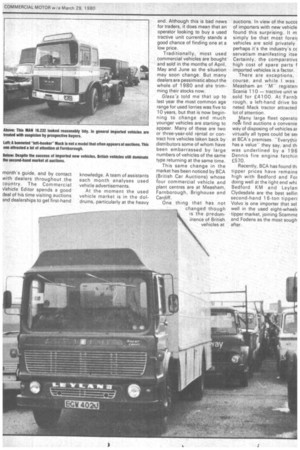British is lies for used lorrie
Page 68

Page 69

If you've noticed an error in this article please click here to report it so we can fix it.
Tim Blakemore assesses the second-hand mark
DAD TRANSPORT is one of e most conservative industries hen it comes to buying and lung vehicles.
Old reputations die hard — to
e chagrin of vehicle manufacrers whose claims of improved .liability for this engine or that parbox are generally ignored -nil the component has proved ;elf over a long period, preferrly in somebody else's fleet. This caution is reflected in
e second-hand market, where is the vehicles with established putations that command the ghest prices.
Two organizations whose isiness it is to be in touch with e used commercial vehicle arket are British Car Auctions d, which regularly holds heavy mmercial vehicle auctions at ur of its centres in the UK, and ass's Guide Service Ltd, proietors and publishers of the mous guide to used vehicle lues. I have recently visited ith companies to learn the ex!rt's view of the current situain.
Glass's Guide was established 1933 by one William Glass ho saw the need for some der to be brought into the ed car market. Since then the icket sized book, published Dnthly, has been "the bible" r used car dealers. When meone says a price is "below 'nom book" Glass's Guide is e book they are referring to. le guide to used commercial hide values (also published Dnthly) was started in 1951. In 1976 valuations for trac e units were included for the first time and the number of makes shown are given for around 65 per cent of the models of tractive units available. Obviously, publishing a guide to commercial vehicle values presents different problems to a price guide, if only because of the variety of specifications available.
Glass's does not attempt to include valuations for all vehicles, but reflects the state of the second-hand market by only including a vehicle once its second-hand sales have reached significant proportions, and there is sufficient knowledge on which to base values.
In order to overcome the difficulty presented by the vast range of different body types fitted to chassis cabs over 3.5 tonnes gvw, the guide's values are for vehicles with dropside bodies, and allowances (up or down) have to be made for other body types (boxvan. Luton, etc).
Tractive units are assumed to be complete with fifth-wheel couplings and the "cost new" figure includes an estimated fifth-wheel price. In order to enrol as a subscriber to the guide, certain stringent conditions have to be met. The success of the publication has been at least partly due to its exclusivity, and this is jealously guarded.
The subscription Manager is in the unusual position of spending more of his time refusing applications than accepting them. It is intended to be a "trade guide" and therefore is not available to the general public. An operator has to run "a large fleet" in order to qualify as a subscriber.
Each month the prices for each vehicle model are arrived at by reference to the previous
month's guide, and by contact with dealers throughout the zountry. The Commercial Vehicle Editor spends a good deal of his time visiting auctions and dealerships to get first-hand
knowledge. A team of assistants each month analyses used vehicle advertisements.
At the moment the used vehicle market is in the doldrums, particularly at the heavy end. Although this is bad news for traders, it does mean that an operator looking to buy a used tractive unit currently stands a good chance of finding one at a low price.
Traditionally, most used commercial vehicles are bought and sold in the months of April, May and June so the situation may soon change. But many dealers are pessimistic about the whole of 1980 and are trimming their stocks now.
Glass's told me that up to
last year the most common age range for used lorries was five to 10 years, but that is now beginning to change and much younger vehicles are starting to appear. Many of these are two or three-year-old rental or contract hire vehicles taken back by distributors some of whom have been embarrassed by large numbers of vehicles of the same type returning at the same time.
This same change in the market has been noticed by BCA (British Car Auctions) whose four commercial vehicle and plant centres are at Measham, Farnborough, Brighouse and Cardiff.
One thing that has not changed though . is the predom . inence of British vehicles at
auctions. In view of the SUCCE of importers with new vehicle found this surprising. It m simply be that most forek vehicles are sold privately perhaps its the industry's cc servatism manifesting itse Certainly, the comparative high cost of spare parts f imported vehicles is a factor.
There are exceptions, course, and while I was Measham an register( Scania 110 — tractive unit w sold for £4100. At Farnb rough, a left-hand drive bo neted Mack tractor attracted lot of attention.
Many large fleet operate • now find auctions a convenie
way of disposing of vehicles ar virtually all types could be ser at BCA's premises. "Everythir has a valuethey say, and th was underlined by a 196 Dennis fire engine fetchin £570.
Recently, BCA has found th. tipper prices have remaine high with Bedford and For doing well at the light end whi Bedford KM and Leylan Clydesdale are the best sellin second-hand 16-ton tipper: Volvo is one importer that sel well in the used eight-wheelr tipper market, joining Scamme and Fodens as the most sough after.




























































































































